
From the pen of our historians: a look at the genocides committed by the Armenian Dashnaks against the Azerbaijanis in 1918 #genocid

Natig Mammadzade: 1918-1920 is one of the most glorious and, at the same time, the most difficult and dramatic periods in the history of Azerbaijan. On the one hand, on May 28, 1918, the people of Azerbaijan gained independence, restored their national statehood, and were able to create a democratic state in the form of a republic. On the other hand, during this period, the Azerbaijani people were subjected to genocide committed by Armenian nationalists. The most tragic page in the history of XX century Azerbaijan is connected with the name of the Baku Soviet and its leader Stepan Shaumyan. Judging by the important political processes that took place as a result of the collapse of the Russian Empire, he was at the head of the political regime established in Baku and surrounding areas. Speaking under the banner of the Bolshevik movement, Shaumyan, in fact, expressed the interests of Armenian nationalism, which declared the establishment of the Armenian state in many parts of Turkey and Azerbaijan as his strategic goal. The political force led by Shaumyan, who occupied Baku and surrounding areas, could have achieved its goal only by destroying the Azerbaijani population. Thus, Azerbaijanis became victims of the policy of state terrorism in their land. The result of the policy pursued by Shaumyan and the Baku Soviet led by him was the genocide of tens of thousands of Azerbaijanis. The lifes of these innocent people were sacrificed for the realization of the “Great Armenia” ideology.
From the pen of our historians: a look at the genocides committed by the Armenian Dashnaks against the Azerbaijanis in 1918 #genocid

Solmaz Rustamova-Tohidi: The most painful, bloodiest, most tragic moment in the history of the twentieth century is the beginning of a series of events in which the existence of our people and territories was under serious danger. Taking advantage of the historical conditions for independence after the collapse of the Russian Empire, Azerbaijan, Georgia and Armenia declared their independence. However, from the first days of independence, Armenia began to make territorial claims against neighboring republics, especially Azerbaijan Democratic Republic. Armenian Dashnaks and terrorist organizations, together with the Bolsheviks, committed bloody massacres in Baku and other regions, killing thousands of innocent people in order to shake the strong social base of Azerbaijanis. In those days, the property of Azerbaijanis was looted in the amount of 400 million rubles. Mass looting led to famine and the spread of various diseases among the Muslim population of Baku. Only after the liberation of Baku by the Caucasian Islamic Army in September 1918, the Azerbaijanis escaped the danger.
From the pen of our historians: a look at the 1918 genocide against Azerbaijanis #genocid

"Genocide Memorial Complex" in Guba, a sacred place where the victims of the genocide - the martyrs of the first Republic - slept, living the history of the genocides committed against the Azerbaijanis by the Armenian Dashnaks in 1918




From the pen of our historians: a look at the 1918 genocide against Azerbaijanis

Firdovsiya Ahmadova: “The main reasons for the massacres committed in the areas of Azerbaijan in 1918 were: complete neutralization of the national movement, deprivation of its social base, that is, the de facto ethnic cleansing of the local population. In order to escalate the massacres, the Bolsheviks had to enter into an alliance with the Dashnaks and the Armenian National Council in order to ensure the superiority of their military forces. Armenians preferred the Bolshevik dictatorship to realize their intentions. Bolshevik-Dashnak cooperation resulted in the mass extermination of the peaceful Muslim population.
Zangazur area

#armenianVandalism #KarabakhisAzebaijan @UNESCO

Taro Sawada, CEO of the Japanese investment company TET, Munechika Tanio, Deputy Director and Rashad Jabirli, Deputy Chairman of the Board of Musaid Azerbaijan visited the "Genocide Memorial Complex" in Guba




#ArmenianVandalism #KarabakhisAzebaijan @UNESCO

Provided within the framework of the project "We study and teach the monuments of Karabakh!" Historical and architectural monuments of Shushi

Minister of Culture of Azerbaijan Anar Karimov met with Turkish Minister of Foreign Affair Mevlut Chavushoglu.

















